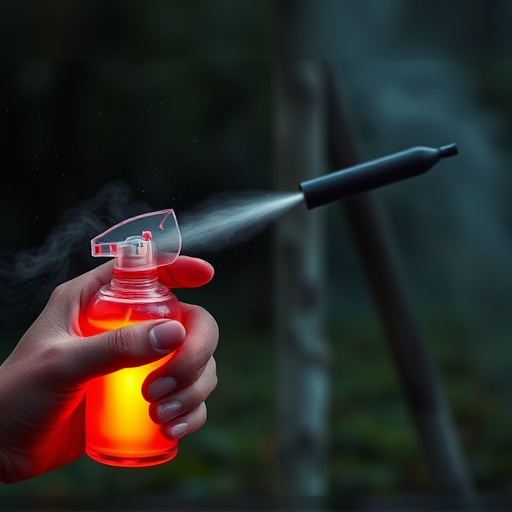Storing pepper spray at home offers personal security benefits but requires careful consideration. Place it in an accessible yet secure location, like near an exit or in a locked drawer, keeping it away from children and pets. Maintain the spray's effectiveness by managing expiration dates, using airtight containers, and regularly checking inventory. Comply with local laws regarding possession, storage (e.g., lockable cabinets, high shelves), and responsible disposal. Understand pepper spray's range, duration, and side effects for informed, legal use as a non-lethal deterrent.
“Personal security is a growing concern, prompting individuals to seek effective non-lethal deterrent options. In this comprehensive guide, we explore one of the most popular choices: pepper spray. From understanding its mechanism and benefits to navigating legalities and safe storage practices, especially for home users, this article covers all aspects. Learn how to make informed decisions and ensure the responsible use of pepper spray for your protection without causing harm. Discover expert tips on storing pepper spray at home for easy accessibility during emergencies.”
- Understanding Non-Lethal Deterrent Devices: A Comprehensive Overview
- The Role of Pepper Spray in Personal Security: Benefits and Considerations
- Storing Pepper Spray Safely at Home: Tips and Best Practices
- Legal and Safety Aspects: Navigating Regulations and Responsible Use
Understanding Non-Lethal Deterrent Devices: A Comprehensive Overview
Non-lethal deterrent devices, such as pepper spray, offer a powerful yet non-deadly means of personal security. These tools are designed to incapacitate or deter potential attackers temporarily, giving users time to escape dangerous situations. Pepper spray, in particular, has become a popular choice for individuals seeking effective self-defense options. It works by irritating the eyes and respiratory system, causing the target to experience temporary blindness and difficulty breathing, allowing the user to retreat to safety.
When it comes to storing pepper spray at home, proper placement is crucial for accessibility and safety. It’s recommended to keep it in an easily reachable location, like near an exit or within quick grab-and-go reach. A secure yet visible spot on a wall or in a drawer, away from children and pets, ensures its availability when needed most. Additionally, understanding the spray’s expiration date and regular maintenance practices are essential for guaranteeing its effectiveness.
The Role of Pepper Spray in Personal Security: Benefits and Considerations
Pepper spray, a non-lethal deterrent, has become a popular personal security device for individuals seeking to protect themselves in various scenarios. Its primary role is to incapacitate an assailant temporarily, providing the user with an opportunity to escape or seek help. The key active ingredient, capsaicin, irritates the eyes and respiratory system, leading to pain and temporary blindness, thus deterring potential attackers.
When considering storing pepper spray at home, it’s essential to weigh the benefits against potential drawbacks. It offers a swift and effective means of self-defense in close-quarters encounters. However, proper handling and storage are crucial to avoid accidental discharge or spoilage of the contents. Users should familiarize themselves with local laws regarding its possession and carry, as well as understand the spray’s range, effectiveness, and safety precautions, ensuring it remains a reliable tool for personal security without causing long-term harm.
Storing Pepper Spray Safely at Home: Tips and Best Practices
Storing pepper spray at home is a crucial aspect of ensuring its effectiveness and safety, especially for individuals prioritizing personal security. The key to secure storage lies in keeping it out of reach from children and unauthorized persons while maintaining optimal environmental conditions. Lockable cabinets or high shelves are ideal locations as they provide physical barriers. Additionally, storing the spray away from direct sunlight, extreme heat, or cold temperatures helps prevent its potency from diminishing over time. Using air-tight containers with clearly labeled dates of purchase can further safeguard its integrity.
Other best practices involve keeping pepper spray in a well-lit area to avoid accidental misuse and ensuring easy accessibility during emergencies. It’s also important to familiarize household members or occupants with the device’s mechanics and intended use, as well as establish protocols for secure disposal once it reaches its expiration date. Regular inventory checks can help maintain accountability, ensuring that the device remains functional when needed most.
Legal and Safety Aspects: Navigating Regulations and Responsible Use
When considering a non-lethal deterrent like pepper spray for personal security, understanding legal and safety aspects is paramount. Regulations surrounding the possession and use of pepper spray vary significantly from region to region, so it’s crucial to research local laws before purchasing or carrying any self-defense device. In many areas, storage requirements for pepper spray at home are strictly enforced, including keeping it out of reach of children and securing it in a locked cabinet or safe.
Responsible use is equally important. Users must be trained in the proper application techniques to ensure effectiveness while minimizing risk of injury to oneself or bystanders. Additionally, understanding the spray’s range, duration, and potential side effects helps users make informed decisions about when and how to deploy it safely and legally.
In conclusion, non-lethal deterrent devices like pepper spray offer a powerful tool for personal security. Understanding their benefits, proper usage, and legal considerations is essential. When it comes to storing pepper spray at home, following best practices ensures safety and accessibility. By being prepared and informed, individuals can confidently navigate potential threats while adhering to responsible use guidelines.
